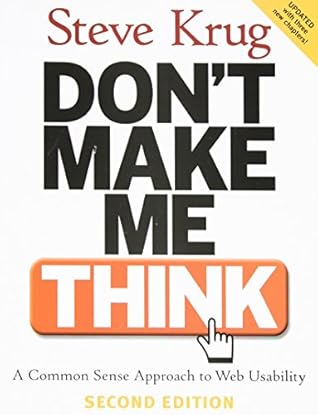More on this book
Community
Kindle Notes & Highlights
“Don’t make me think!”
should be able to “get it”—what it is and how to use it—without expending any effort thinking about it. Just how self-evident are we talking about? Well, self-evident enough, for instance, that your next door neighbor, who has no interest in the subject of your site and who barely knows how to use the Back button, could look at your site’s Home page and say, “Oh, it’s a _____.” (With any luck, she’ll say, “Oh, it’s a _____. Neat.” But that’s another subject.)
The most important thing you can do is to just understand the basic principle of eliminating question marks.
Making pages self-evident is like having good lighting in a store: it just makes everything seem better.
the thing that has struck me most is the difference between how we think people use Web sites and how they actually use them.
What they actually do most of the time (if we’re lucky) is glance at each new page, scan some of the text, and click on the first link that catches their interest or vaguely resembles the thing they’re looking for.
the fire commanders didn’t compare any options.
They took the first reasonable plan that came to mind and did a quick mental test for problems. If they didn’t find any, they had their plan of action.
We don’t figure out how things work. We muddle through.
your audience is going to act like you’re designing billboards, then design great billboards.
When you’re designing Web pages, it’s probably a good idea to assume that everything is visual noise until proven otherwise.
what really counts is not the number of clicks it takes me to get to what I want (although there are limits), but rather how hard each click is—
17. Omit needless words. Vigorous writing is concise. A sentence should contain no unnecessary words, a paragraph no unnecessary sentences, for the same reason that a drawing should have no unnecessary lines and a machine no unnecessary parts.1
Removing half of the words is actually a realistic goal; I find I have no trouble getting rid of half the words on most Web pages without losing anything of value.
I’m really talking about two specific kinds of writing: happy talk and instructions.
Your objective should always be to eliminate instructions entirely by making everything self-explanatory, or as close to it as possible. When instructions are absolutely necessary, cut them back to the bare minimum.
If you choose to browse, you make your way through a hierarchy, using signs to guide you.
Clear, well-thought-out navigation is one of the best opportunities a site has to create a good impression.
It’s vital to have sample pages that show the navigation for all the potential levels of the site before you start
arguing about the color scheme for the Home page.
Designers love subtle cues, because subtlety is one of the traits of sophisticated design. But Web users are generally in such a hurry that they routinely miss subtle cues.


